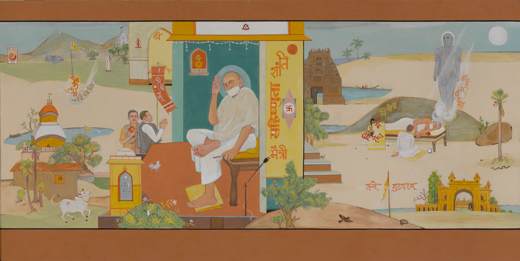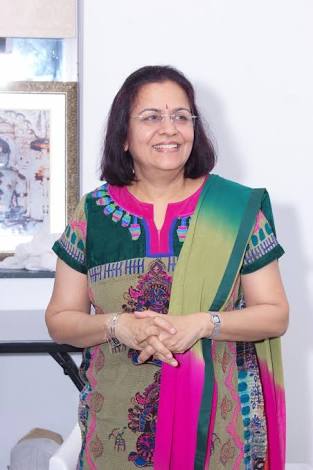(9th Acharya of Jain Swetambar Terapanth sect)
A Mural Painting by Dr. Manju Nahata
Size: 56 feet x 4 feet Base: Cloth mounted on the board Medium: Tempera, Earth colours
JOURNEY ON FOOT
(Panel 4)

[ large size ]
A year before Tulsi came to Kolkata his followers established ‘Mitra Parishad’ in 1958, with the motto of Seva (service) and Samarpan (dedication). In the course of his journey on foot Acharya Tulsi arrived at Kolkata. Before his arrival he travelled many provinces in his pada-yatra. Hence, the phrase ‘Jai Guru charaiveti’ at the end of a flag. In the upper section ‘Sammed Shikhar’ a mumukshu sister Kala (Sadhvipramukha as she is called today) is shown standing devotedly. At this place she got the order from Acharya Tulsi to become a Sadhvi.
Kalighat temple, a landmark of Kolkata, has been drawn close by. A holy cow is shown trotting towards Acharya Tulsi. This motif is a piece of artistic imagination to bring home the fact that Acharya Tulsi was very fond of this docile animal. We notice a look of quietness and affection in the eyes of cow and those of Acharya Tulsi.
We find Acharya Tulsi in blessing mudra showing three fingers for his primarily important preaching: friendliness, tolerance and peace. The preaching is written behind his back, as he is seen seated on a stool with his right leg resting on the left. It is to be noted that Acharya Tulsi has used the public address system through microphone. Two fish drawn on the architectural motif stands for ‘agar’ and ‘anagar’ i.e. house holders and sadhu.
In future, Acharya Tulsi wants to travel in South India. A passionate follower of Acharya Tulsi, Sri Khemchand Sethia, coincidentally requested Acharya Tulsi that he be given an opportunity to arrange for his travel south. All his hesitance was dispelled when Acharya Tulsi agreed. It was a rare moment of bliss for Sri Khemchand Sethia, shown here with folded hand standing before Acharya Tulsi, with a person by his side, Late Suganchand Anchalia, who was a friend and philosopher of Sethia. The panel depicts Gopuram, an entrance to the temple (southern style). In his sleep Acharya Tulsi had a dream of Bahubali (Shravanbelgol’s Gommateshvaram), where he had had his visit already. Acharya Tulsi, in his southern yatra composed the ‘Arhat-Vandana’, an evening prayer which we say now-a-days.
Despite opposition from several sects, language barriers etc., Acharya Tulsi won over a considerable number of followers, who welcomed him with the words ‘Vande Guruvaram’. At the far end of the panel, above Mysore Palace, a snake is shown swishing away, suggesting the idea that venom disappears in presence of sacredness.
 Dr. Manju Nahata
Dr. Manju Nahata